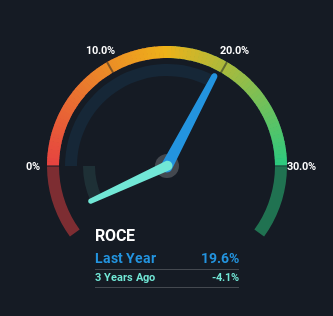Brookside Energy (ASX:BRK) Knows How To Allocate Capital Effectively
There are a few key trends to look for if we want to identify the next multi-bagger. Ideally, a business will show two trends; firstly a growing return on capital employed (ROCE) and secondly, an increasing amount of capital employed. This shows us that it's a compounding machine, able to continually reinvest its earnings back into the business and generate higher returns. Speaking of which, we noticed some great changes in Brookside Energy's (ASX:BRK) returns on capital, so let's have a look.
Understanding Return On Capital Employed (ROCE)
For those who don't know, ROCE is a measure of a company's yearly pre-tax profit (its return), relative to the capital employed in the business. Analysts use this formula to calculate it for Brookside Energy:
Return on Capital Employed = Earnings Before Interest and Tax (EBIT) ÷ (Total Assets - Current Liabilities)
0.20 = AU$15m ÷ (AU$90m - AU$13m) (Based on the trailing twelve months to June 2023).
So, Brookside Energy has an ROCE of 20%. In absolute terms that's a great return and it's even better than the Oil and Gas industry average of 16%.
View our latest analysis for Brookside Energy
Historical performance is a great place to start when researching a stock so above you can see the gauge for Brookside Energy's ROCE against it's prior returns. If you'd like to look at how Brookside Energy has performed in the past in other metrics, you can view this free graph of past earnings, revenue and cash flow.
How Are Returns Trending?
Brookside Energy has recently broken into profitability so their prior investments seem to be paying off. The company was generating losses five years ago, but now it's earning 20% which is a sight for sore eyes. And unsurprisingly, like most companies trying to break into the black, Brookside Energy is utilizing 565% more capital than it was five years ago. This can indicate that there's plenty of opportunities to invest capital internally and at ever higher rates, both common traits of a multi-bagger.
For the record though, there was a noticeable increase in the company's current liabilities over the period, so we would attribute some of the ROCE growth to that. The current liabilities has increased to 15% of total assets, so the business is now more funded by the likes of its suppliers or short-term creditors. It's worth keeping an eye on this because as the percentage of current liabilities to total assets increases, some aspects of risk also increase.
Our Take On Brookside Energy's ROCE
To the delight of most shareholders, Brookside Energy has now broken into profitability. Astute investors may have an opportunity here because the stock has declined 31% in the last five years. So researching this company further and determining whether or not these trends will continue seems justified.
On a final note, we found 3 warning signs for Brookside Energy (1 is a bit concerning) you should be aware of.
Brookside Energy is not the only stock earning high returns. If you'd like to see more, check out our free list of companies earning high returns on equity with solid fundamentals.
Have feedback on this article? Concerned about the content? Get in touch with us directly. Alternatively, email editorial-team (at) simplywallst.com.
This article by Simply Wall St is general in nature. We provide commentary based on historical data and analyst forecasts only using an unbiased methodology and our articles are not intended to be financial advice. It does not constitute a recommendation to buy or sell any stock, and does not take account of your objectives, or your financial situation. We aim to bring you long-term focused analysis driven by fundamental data. Note that our analysis may not factor in the latest price-sensitive company announcements or qualitative material. Simply Wall St has no position in any stocks mentioned.

